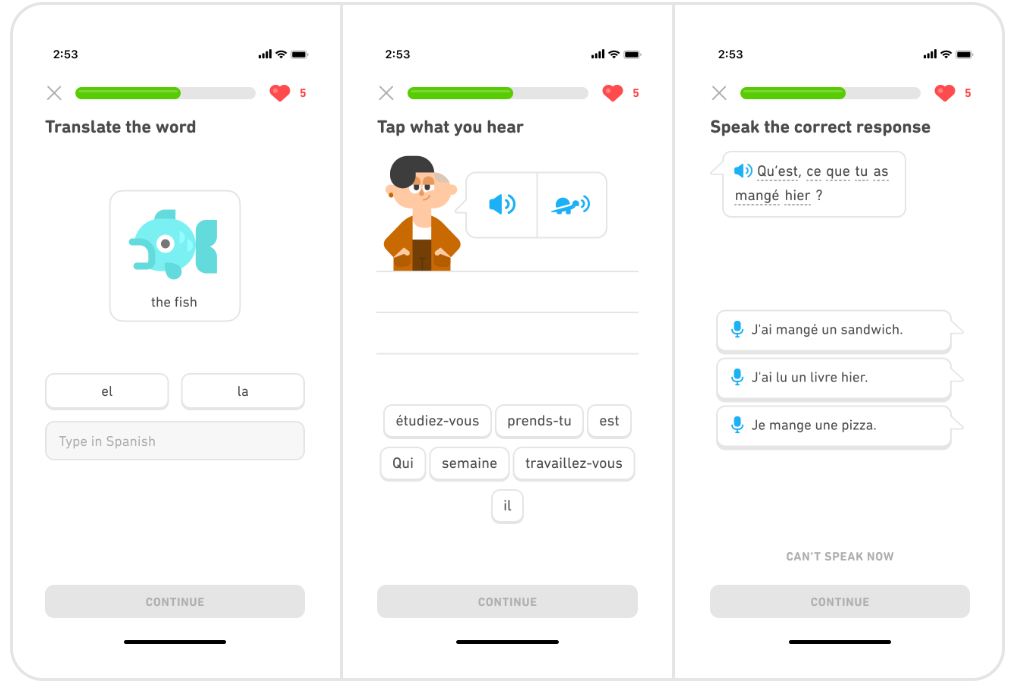How to Create a Language Learning App Like Duolingo?
Learning a second language can be a challenging endeavour. But new language learning apps are demystifying the entire learning experience. Dictionaries or textbooks are no longer the only sources of mastering them.
AI and gamification are new aids to reinforce vocabulary and ace your first conversation.
The good news is you can build your own language-learning platform! In this blog, we have covered practical tips on how to create a language learning app like Duolingo.
So, let’s get started!
How Does Duolingo Work?
First, let’s understand how Duolingo works!
Duolingo is basically an AI-powered language-learning app. It provides English, Spanish, and French lessons.
Let’s see how Duolingo works for learners!
Learners pick a language to start learning.The platform puts forth a few questions about their motivations and goals.
Each unit includes practice tests, short dialogues, and reading exercises. As the user progresses, the complexity of lessons increases. Then, there’s gamification to keep them motivated. Streaks, leaderboards, challenges, and gems are the major dopamine boosts.
The platform runs on a freemium model. While the basic lessons are free for all, subscriptions unlock ad-free experiences, streak freezes, and unlimited hearts. Duolingo monetizes through subscriptions, in-app purchases, and standardized test programs.
Well, that sums up how the platform works!
Why Create a Language Learning App Like Duolingo?
Duolingo is the most downloaded educational app, attracting curious linguists from around the globe.
From gamification to AI learning, Duolingo has embraced everything it needs!
Benefits of building a language learning app like Duolingo are:
-
Potential Market Demand
The global language learning app market size was $4.96 billion in 2024. An increase in mobile users, demand for multilingual skills, and globalization are major drivers. On the technology side, gamification and AI are changing how we learn a language.
-
High Revenue
Duolingo’s total revenues were $748 million in 2024. Its major revenue streams are subscriptions, in-app purchases, and language proficiency tests.
-
Connect Learners with Linguists across the Globe
Reportedly, 1.5 billion people are inclined towards mastering a second language. English, Spanish, French, and Mandarin Chinese are the most in-demand second languages.
-
Make Language Learning Fun & Interactive
Now, streaks, leaderboards, and AI models define the new entertaining way of language learning.
-
Growth Potential
There are many language learning niches still untapped. Less-common or minority languages, industry-specific language courses hold immense potential. You can scale your app with personalized learning, conversational practice, or pronunciation modules.
How to Create a Language Learning App Like Duolingo: 7 Key Steps
Building a language learning app like Duolingo demands a complete development process. From the basic platform idea to the final launch, you need thorough planning.
Step 1: Determine a Profitable Niche & Research Market
The first step is to lay the groundwork for your language learning app.
Spoiler alert: You need to come up with a strong and unique idea!
Brainstorm ideas based on what’s working now. Tap into the relevant market trends & opportunities. For example, AI and micro-learning are shaping the language learning space.
Strategies to choose the right niche:
-
Identify High-demand Niches
Look for high-potential niches in the language learning space. This increases your revenue-making potential and assures the long-term success of your business. AI-powered language learning platforms, gamified learning, and niche languages have recently witnessed a huge demand.
See what users are looking for online. Use tools like Semrush, Ahrefs, and Google Keyword Planner to find high-volume keywords.

-
Perform Competitor Analysis
To identify a high-potential niche, see what’s hot in the market. List the major players disrupting the space. Download their app; study their features, interface, lesson structure, etc. Take a step beyond and go through the comments on the App Store.
Spot their user pain points, likes, dislikes, and their unmet needs. Further, look into their pricing, engagement, and promotional strategies. Thus, you can better position your platform.
-
Assess the Industry Gaps
A quick look at the OGs reveals the underserved segments. Duolingo proved that Business English, exam preparation, and cultural context training have market potential. These are like missing pieces to launch your language learning business.
-
Identify the Target Audience
Want to create a language learning app tailored for your audience? Research your audience’s language expertise, age, and learning objectives. Ask questions: Are you targeting students, professionals, or expats? Surveys, interviews, and online forums can reveal much.
Step 2: Choose a Monetization Strategy
You have found a basic idea to build your learning app. Now, decide on a main revenue and few additional revenue streams.
Let’s explore all the common revenue models in the industry:
-
Freemium Model
In this model, you can use basic app features for free, while premium upgrades require a fee. This is great for building your initial audience. Once learners are committed to your app, persuade them to go premium.
Duolingo runs on the freemium business model. Users can access gamified lessons, quizzes, and challenges for free. Typically, the premium tier includes offline access, ad-free learning, unlimited hearts, and more.
-
Subscription Model
Want to drive recurring revenue from language learning lessons? Offer your language lessons for a monthly/yearly subscription plan. Here, the free version has basic language learning lessons. And subscriptions offer advanced lessons, extra practice exercises, and unlimited streaks.
-
In-App Purchases
Learners can take pride in buying a chest of gems or a barrel of gems pack. Even one-time purchases like test preparation packs and course packs rakes in more revenue.
This is often used along with subscriptions and freemium models.
-
Ads and Sponsorships
You can monetize from related third-party ads. But there’s a catch to it — no compromises on the learning experience.
Include them between the language lessons or try video reward-based ads. For every click on a partner ad, the user earns revenue. Leverage ad networks like Google AdMob and Facebook audience networks.
-
Corporate Licensing
Corporate licensing capitalizes on the growing market of educational institutions or companies. This involves developing specialized learning modules for them. Customers have to pay a licensing fee for software access.
Choose your monetization strategy based on your goals and target audience.
Step 3: Decide the Core Features
Now, you know your audience in and out. You’re aware of their needs, pain points, and expectations. This helps to choose the features & functionalities that better resonate with them.
Start with deciding the learning objectives of your app. Thus, you can come up with the right features.
Essential Features for Language Learning App
- Simple login & sign up
First off, you need a simple and secure login & registration for learners. Users can sign up within a few seconds with social login.
- Language & course selection
Your app hosts lessons for diverse languages & expertise (e.g., beginners, intermediate, experts). Add course discovery features like a search tool and filter options.

- Speech recognition and pronunciation feedback
Whether you’re perfecting the TRAP vowel pronunciation or regional accents, AI could make your work easier. AI algorithms could offer real-time feedback on your pronunciation and translation. Best of all, without the help of teachers or other students.
- Structured lessons modules or microlearning
Organize your lessons into bit-sized modules or videos (approx. 5-15 minutes). Microlearning is perfect for mobile users who can plan their lessons accordingly.

- Payments
Integrate with secure payment gateways, such as PayPal, for convenient transactions.
- Notifications
Send push notifications on pending lessons, new course launches, or streak reminders.
- Flashcards & Interactive lessons
Flashcards can build your vocabulary skills over time. Add a punch of interactivity with videos, images, and audio clips.
- Progress tracking
Track your lessons, streaks, and challenges. This helps to understand how far you reached in your learning journey.
Other gamification and engagement features
- Daily Streaks
- Leaderboards
- XP Points
- Weekly Challenges
- Streak reminders
- Badges
- Quizzes
📚 Important:
Step 4: Choose the Right Tech Stack
It’s time you get started with the actual development process. Identify the relevant tech stack and frameworks needed for language learning.
Android Development Framework
Front-end – Java, Kotlin
Back-end – Node.js , Python
iOS Development Framework
Front-end – Objective C and Swift
Back-end – Node.js or Django
Database – PostgreSQL
Cross-platform Framework
Front End – Flutter
Back End – Node.js
Database – PostgreSQL, Redis
Speech recognition -Google Speech-to-Text
AI/ML frameworks– Python models with API/ Tensorflow
Lack the technical expertise for custom-development? Leverage a market-ready clone script like Pinlearn to launch a language learning platform like Duolingo. From personalized lessons, interactive quizzes, and speech recognition, create a customizable solution tailored to learning goals!
Step 5: Create Content for the Language App
Now, it’s time you plan the app content. While features and business models are important, content quality should be your priority.
Think about unique, relevant and engaging content that keeps learners committed. Cover writing, reading, listening, and speaking skills. Add grammar lessons, practice tests, vocabulary & pronunciation enhancement exercises.
How do you create a relevant and up-to-date curriculum? Follow Duolingo’s stride. Collaborate with language teaching experts who can use their years of expertise.
Planning a Language Curriculum
- Learning Goals- Start with setting learning goals for your audience. The goals become complex as the expertise level ups. For A1(beginner-level), goals could be learning words, numbers, and greetings. Subsequently, A2 could be learning tenses and common phrases.
- Create Curriculum Structure – Divide it into modules, lessons, and topics. Duolingo adopts the skill tree approach.
- Spice up with activities – It’s time to jazz up with some fun and interactivity. Add quizzes, fill-in-the-blanks, flashcards, and type translations.
- Spaced Repetition Technique – It is a scientific learning technique for better retention. For example, learn a new concept (grammar or vocabulary). Revisit after 1 day, one week, likewise, for increasing time intervals. Babbel and Memrise employ this technique.
- Real-life scenarios – Include practical situations like “ordering food” or talking with strangers” This puts your conversation skills to the test.
💭 Important Tip: Incorporate audio, video, images and visual learning into lessons. Recommend related books & articles for every topic to provide a well-rounded learning.
Step 6: Add the Gamification & AI Layer
Now, you have the basic educational content all set up. AI and ML adds extra personalization.
AI and ML learning are great for analyzing user behaviour, identifying learning patterns, and creating personalized learning paths.
Chatbots, NLP and virtual language tutors are powerful AI technologies. Virtual tutors can consider the strengths and weaknesses of learners.
Whether it’s a quiz, grammar, or pronunciation exercise, AI algorithms can surprise you with feedback!
Streaks, XP points, weekly goals, and leaderboards enliven the learning process. And there’s actual research backing this!
Duolingo’s streak frenzy is deeply rooted in habit-building.
Step 7: Deploy & Maintain the App
Finally, it’s time to hit the launch!
Here, you need to plan for a smooth release on different platforms like iOS, Android, and the web.
Conduct the final checks: security, server configuration, and back-end setup. App listings include descriptions, icons, and screenshots.
After the final deployment, provide maintenance updates and ongoing support alive. Lesson updates, bug fixes, compatibility, and security patches are part of the update schedule!
How to Market Your Language Learning App?
The language learning app market is quite competitive, with new players emerging every other day.
There are the big fishes like Duolingo, Babbel, Bussu, and Memrise. Then, there are the emerging players vying for space.
-
Influencer Marketing
Reach out to language influencers and bloggers to market your app. You could also partner with travel apps and related businesses to broaden your reach.
-
Social media marketing
Social media is a strategic place to create hype around your language learning app. Duolingo’s viral marketing strategy with its beloved mascot Duo is exemplary. It actively promotes on TikTok, Twitter, & Instagram. Share interface snippets, success stories, and language learning tips.

-
Optimize for App Store
Add relevant app descriptions, screenshots, and visuals. This creates an optimized app listing for the store. Include relevant keywords to appear for the right queries.
-
Paid Advertising
Apple Search Ads, Meta Ads, and Google Ads broaden your reach. Create ad campaigns for specific audience segments. This includes international travellers, students, professionals, etc.
-
Blogs & Case Studies
Cover blogs & case studies on market trends or peculiar language facts, tips, and accents. Start an expert advice column like “Dear Duolingo”, where you address user queries.
-
Email Marketing Campaigns
Run email campaigns on topics like “new word of the day”, “cultural trends”, streak challenges, etc. Send newsletters covering trends, tips & recent news.
-
Referral Program
Create attractive referral and bonus programs for existing users. Duolingo referral programs invite learners to the app and earn 1 week of free access to Duolingo Plus.
What is the Cost to Create a Language Learning App Like Duolingo?
Custom-development needs building from scratch and an extensive budget. The development cost is influenced by several factors. And the development process spans across multiple stages. From research to UX design and testing, here’s an approximate estimate.
| Duolingo Feature | Development Time (in weeks) | Development Cost($40 per hour) |
| Research & Concept | 3 – 4 weeks | $5000 – $12,000 |
| UI/ UX Design | 5 – 6 weeks | $15,000 – $30,000 |
| Front-end Development | 2 – 3 weeks | $12,000 – $40,000 |
| Back-end Development | 2 – 3 weeks | $20,000- $45,000 |
| Speech Recognition | 2 – 3 weeks | $10,000 – $15,000 |
| AI/ML Integration | 5 – 6 weeks | $5,000 – $12,000 |
| Gamification | 3 – 4 weeks | $5,000 – $15,000 |
| Testing & QA | 3 – 4 weeks | $5,000 – $10,000 |
| Marketing | Variable | $6,000 – $10,000 |
| Maintenance Cost & Updates | Ongoing | $5,000 – $8,000 per year |
| Total Development Cost | 7 – 12 months | $80,000 – $100,000+ |
Final Few Words
Stepping into the language learning industry is more profitable than ever! And, to make it easier, here’s a detailed roadmap on how to create a language learning app like Duolingo.
The winning strategy is to choose the right development approach and business model. Have a breakthrough idea for your language learning app? We at Pinlearn can help you build your language-learning empire. Whether it’s an AI-powered learning solution or a language exchange platform, we are here to help you!
Book a 15-minute call to find an estimate and see how we can crystallize this together!
💬 Related:
FAQ-Related to How to Create a Language Learning App Like Duolingo
1. How do you develop an app like Duolingo?
Here’s a step-by-step guide to build an app like Duolingo:
- Determine a profitable niche & research market
- Choose a monetization strategy
- Decide your core features
- Choose the right tech stack
- Create platform content
- Add the Gamification and AI layer
- Deploy & Maintain the App
- Market the Language App
2. What programming language is required to develop Duolingo?
Below are the development frameworks:
- Front-End: Javascript
- Back-End: Python
- App development: Kotlin (Android), Swift (iOS)
3. How much money do I need to build an app like Duolingo?
The cost to develop a language learning app like Duolingo is roughly $80,000 to $100,000. Factors like features, platform, and location influence the cost.
4. How do apps like Duolingo make money?
Duolingo adopts a freemium model. It primarily monetizes from subscriptions, in-app purchases, and language proficiency tests. Users pay for Super Duolingo or Duolingo Max subscriptions. They get an ad-free learning experience and other benefits.





